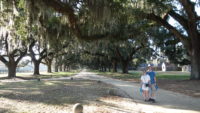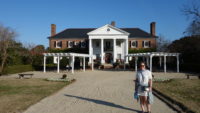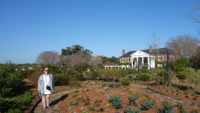 Dubbs was in charge today, and after a quick breakfast (the place was open, but Meredith’s first choice was sold out, so her eatery streak continues), we headed over to Boone Hall Plantation, which is just outside of Charleston.
Dubbs was in charge today, and after a quick breakfast (the place was open, but Meredith’s first choice was sold out, so her eatery streak continues), we headed over to Boone Hall Plantation, which is just outside of Charleston.
Boone Hall Plantation has a dramatic entrance, with a three-quarter-mile long dirt drive lined with huge live oaks. The oaks frame a classic-looking brick building with tall white columns holding the roof of the porch, but as classic as the house is, it was only built in the 1930s, replacing a rather ordinary-looking farm house. Still, the drive and the house are sufficiently picturesque that they were used in the 1980s mini-series North and South and also for the movie The Notebook. Both shows used the exterior only – the inside is very nice, but smaller than most people would expect from a “mansion,” as it only goes back a little ways (one large room wide on the main floor).
We got there about 9:30, so we hung around the house for the 10:00 tour. We passed much of the time wandering the flower gardens flanking each side of the front of the house. The gardens had brick paths that wound through many flower beds and trees, and while one side was being prepared to be planted with winter flowers, the other side was already done and so was largely in bloom.
 The house tour took about thirty minutes, and only covered three main rooms on the ground floor. The house is still privately owned, and the family lives on the second and third floors. We saw a large library (with two grand pianos), the dining room, and a very pretty enclosed porch connected to the men’s smoking room. The entire downstairs was decked out for Christmas, and all smelled of pine from the multiple trees in the house. It was very pretty.
The house tour took about thirty minutes, and only covered three main rooms on the ground floor. The house is still privately owned, and the family lives on the second and third floors. We saw a large library (with two grand pianos), the dining room, and a very pretty enclosed porch connected to the men’s smoking room. The entire downstairs was decked out for Christmas, and all smelled of pine from the multiple trees in the house. It was very pretty.
After the house, we made our way over to the the eight houses remaining from the slave quarters. They are now all small museums, showing how slave life was on the plantation, moving though the Civil War and emancipation into the Jim Crow laws of the late 1800s and 1900s, and then moving though the Civil Rights movement. It was very thoughtfully done.
 We finished our time at Boone by taking a “trolley” ride (carts pulled by a tractor). It took us on a tour of much of the rest of the seven hundred acres of land the plantation still owns. The property is the oldest continuously worked farm in North America, having been settled in 1681. The land didn’t have enough fresh water to raise rice, which was very profitable, so they raised cotton instead until the late 1800s, when bigger and more modern plantations drove the price of cotton too low. The farm then switched over to pecan trees, and became the biggest pecan orchard east of the Mississippi. Pecan trees, it seems, have a shallow root system, so the grove was mostly wiped out by two hurricanes (one in the early 1900s and one in the 1980s). The farm now grows a variety of crops, employing ten farmers, and hosting multiple “U-pick” crops each season.
We finished our time at Boone by taking a “trolley” ride (carts pulled by a tractor). It took us on a tour of much of the rest of the seven hundred acres of land the plantation still owns. The property is the oldest continuously worked farm in North America, having been settled in 1681. The land didn’t have enough fresh water to raise rice, which was very profitable, so they raised cotton instead until the late 1800s, when bigger and more modern plantations drove the price of cotton too low. The farm then switched over to pecan trees, and became the biggest pecan orchard east of the Mississippi. Pecan trees, it seems, have a shallow root system, so the grove was mostly wiped out by two hurricanes (one in the early 1900s and one in the 1980s). The farm now grows a variety of crops, employing ten farmers, and hosting multiple “U-pick” crops each season.
 We drove back into downtown Charleston to go to the Gibbes Museum of Art. It is a small but well-laid-out museum of three floors. The top floor was given over to a featured artist who experimented with abstract paintings and collages. The second floor was largely given over to landscape artists who worked in and around the city, and the first floor was largely made up of portraits. There were a couple of rooms of French Impressionists as well. We spent a little over an hour at the museum.
We drove back into downtown Charleston to go to the Gibbes Museum of Art. It is a small but well-laid-out museum of three floors. The top floor was given over to a featured artist who experimented with abstract paintings and collages. The second floor was largely given over to landscape artists who worked in and around the city, and the first floor was largely made up of portraits. There were a couple of rooms of French Impressionists as well. We spent a little over an hour at the museum.
We walked down the road a bit to try the dessert place Meredith had wanted to go to last night, and this time it was open. All three of us got fancy ice cream sandwiches, which we ate outside on a bench in the warm sunshine. We took advantage of the nice day to walk over to the main semi-open-air market, which is four blocks long, in roofed-in buildings. Inside, people were selling jewelry, food, clothing, toys, hats, art, and more. We may have taken advantage of fresh mini donuts (about the size of a quarter).
We headed back to the car, but got distracted by the Circular Congregational Church, a large circular church built in 1890, but with congregational roots back to the 1690s. I saw a still legible tombstone from the 1790s, so there has been a church here for some time. We spent a lot of time wandering around the churchyard trying to read inscriptions on tombstones.
That was about it. We went back home to rest, and then went out for pizza, where the guy warned us the wait time was about forty minutes because he was so busy. There only seemed to be two people working, and last night we were turned away from a half-empty restaurant due to staffing shortages. It made me wonder if this is going to be the way things will be for a time with the latest Covid surge. Still, we got fed, and the pizza was good.
That wrapped up Dubbs’ day today. I’m in charge tomorrow, which always makes me a little anxious to fill the day productively, but not exhaust us in the touring of things. It’s a fine balance to strike, but Charleston has been a fun and lively place to tour so far, so I think things will turn out okay.